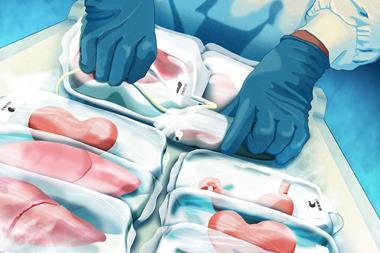The Irish government has highlighted biotechnology as key to creating an innovation and knowledge-based economy. Mark Whitfield reports.
The Irish government has highlighted biotechnology as key to creating an innovation and knowledge-based economy. Mark Whitfield reports.
Ireland has become a country of choice for multinational pharmaceutical companies to base their manufacturing facilities, over the past four decades. Indeed, many now have large operational and administrative headquarters there. The industry employs around 17 000 people in the country with 83 operational plants. Export sales in pharmaceuticals and active pharmaceutical ingredients (APIs) totalled almost € 29bn in 2003.
The initial attraction to Ireland, in the 1960s, was the tax regime on offer to investors from overseas, with low corporation tax and export tax relief meaning, basically, that if you exported all that you made in Ireland you paid little, if any, tax. However, the competitiveness of this benefit has now been reduced through an increase in corporation tax. So, in the late 1990s, the Irish government set out to attract potential overseas investors in a different way.
The government and IDA Ireland (formerly the Industrial Development Authority) clearly identified overseas investment in pharmaceuticals as a national opportunity. Presently, nine of the top 10 global pharmaceutical companies have bases in Ireland and the pharmaceutical industry accounts for around 80 per cent of the nation’s chemicals and pharmaceuticals sector.
In 1998, the government implemented its Technology Foresight exercise which looked at the future of industry in Ireland as far ahead as 2015. This exercise, through a programme of lectures, seminars and workshops, and involving government, academe and industry, was far-reaching and intended to provide a foundation for investment in science and technology in Ireland and create more jobs for the nation.
Government focus shifted towards the creation of an innovation- and knowledge-based economy and to establish Ireland as a centre of excellence through the development of significant research and development activity. A € 2.54bn programme of investment in research and development, as part of a ’national development plan’ was launched.
Two distinct sectors emerged from the Technology Foresight exercise as targets for future government policy and fiscal support - biotechnology and information and communication technology (ICT). It became government policy to increase the level of pharmaceutical and bioprocessing research and development in the country and to continue to identify areas in industry where commitment to biotechnology will have a return in pharmaceuticals and therapeutic advances.
Ireland has an established pharmaceuticals production infrastructure, an engineering/design and build expertise and an education system which is providing the right people with the right qualifications for the pharmaceutical industry, says Pat MacGovern, responsible for international pharmaceutical and biopharmaceutical investment at the IDA. ’In Ireland we have a "can do" attitude in the engineering and manufacturing sector and from government. It is regarded as a good operating environment for the pharmaceutical industry. The accountants must now be convinced that the operational benefits of investing in Ireland outweigh the attractive tax regimes elsewhere,’ he says.
This competition for overseas investment comes principally from Singapore and Puerto Rico which both offer very attractive tax levels between zero and three per cent, he explains. Companies that invested in Ireland in the 1960s enjoyed zero tax on export sales. Corporation tax was subsequently imposed at 10 per cent and companies that have paid this rate will see it in place until 2010, rather than paying the 12.5 per cent that is the standard rate of corporation tax today and is applicable to all businesses, including new investments.
Companies move in
The tax benefit on export sales was very attractive to manufacturers of APIs and the international pharmaceutical industry began its move into Ireland in the 1960s. First to arrive was Bristol-Myers Squibb in 1963. At this time Ireland had no indigenous pharmaceutical industry.
In 1969 Pfizer set up a citric acid plant in Cork, where there is now a significant pharmaceuticals cluster. There then followed a series of mainly US investments in the production of, predominantly, APIs. Merck, Schering Plough, Eli Lilly and Syntex (now part of Roche), among others, all followed in the 1970s.
During the 1980s and early 1990s there was a shift towards investment in the secondary pharmaceutical industry providing increasing volumes of finished product and more employment than in APIs. The largest of these investments was by Wyeth, whose manufacturing and distribution facility, initially established for tablet-making, in Newbridge, County Kildare, was launched in 1992.
The new industry remains US dominated, with GlaxoSmithKline being the only major UK investor (additionally, Athlone Pharmaceuticals produces a range of generic pharmaceuticals). France, through Aventis Pharma, Servier and Beaufor Ipsen; Germany with Merck, Cara Partners, Clonmel Healthcare and Gerard Laboratories; and Switzerland’s Roche and Novartis are all significant players.
Investing in research
As a direct consequence of the Technology Foresight exercise, Science Foundation Ireland (SFI) was created. SFI is responsible for investing € 646m between 2001 and 2006 in academic research in biotechnology and ICT. This is to be achieved through grants based on international peer review. The funding is available under Ireland’s National Development Plan which will allocate a total of € 2.54bn over the period.
SFI director general William Harris says that SFI will be responsive to the country’s research community: ’We will be collegial. We will serve as a determined advocate of two particular areas of emphasis; engineering and science.’ The foundation will also contribute to existing education and research programmes, ’stimulate discovery and innovation and magnify the impact of good ideas’.
Maurice Treacy, director of SFI’s biotechnology division says that the foundation is a component of the government’s strategy to develop and grow research and development activity in Ireland within the private sector. It will achieve this in two ways, he says ’through identifying and training students with the appropriate qualifications and skills required now and in the future by the pharma sector; and by facilitating research collaborations between industry and academia.’
As an example of the success of the programme, Treacy points to Wyeth’s current investment and research programme in Ireland. The company is investing $1.5bn (?800m) to expand its production facilities through the construction of a multi-product biopharmaceutical ’campus’ at Grange Castle, in Clondalkin, Dublin. The facility will employ 1300 people at full production, bringing the company’s total workforce in Ireland to 3000.
Wyeth’s director of external relations and communications, Peter O’Brien, explained that his company’s decision to expand in Ireland - it has been manufacturing there for the past 30 years - was down to five reasons: the availability of a suitable location - the 90 acre site has full services already available; the quality of the available workforce - 1000 of the proposed 1300 have already been recruited; the very ’pro-business’ environment; attractive corporation tax at 12.5 per cent; and the increasing focus on research and development.
Wyeth is also conducting collaborative research, with SFI-funded researchers, at the Conway Institute at University College Dublin, Trinity College Dublin and the Royal College of Surgeons in Ireland (RCSI) on neuro-biotherapeutics. The company is also working in collaboration with Martin Clynes at Dublin City University to optimise processes and systems for bioproduction .
The Grange Castle facility is designed to produce the bioprocessed treatment for rheumatoid arthritis and other arthritis-related conditions, Enbrel; a number of conjugates for pneumococcal vaccine Prevenar; and Wyeth’s new antibiotic Tygacil for treating hospital infections which is currently coming out of Phase III tests and could be launched in late 2006.
Treacy says that despite great perceived differences between the two areas identified by the Technology Foresight exercise - biotechnology and ICT - there are many places where the two disciplines converge, for example in the area of systems biology which involves data capture and data management (in data-rich genomics and proteomics research for example), where advanced informatics facilitate data analysis, iterative experimental design and research efficiency.
As an example of this, SFI is co-funding collaborations between Siemens and RCSI. Siemens Research Ireland was formed as part of SFI’s industry-research partnership programme located at RCSI. SFI will invest € 700 000 while Siemens will contribute matching costs associated with the venture.
Collaborative research
The key to SFI’s work in collaborative research, Treacy says, is that the academic and industrial partners have the same shared objectives, and that much of his and the foundation’s time is spent ensuring that objectives are truly shared. As he puts it: ’SFI is building the intellectual capital within research in Ireland, and we are leveraging this asset to facilitate worthwhile and meaningful partnerships with industry. The scientists are the drivers, with SFI acting as a facilitator. It is also important that there is a continuum between research, collaboration and commercialisation. All SFI investments include conditions that ensure that intellectual property arising from the collaborations is managed and commercialised to the benefit of the people of Ireland - a payback for the real investors in this programme.’
In terms of the measurement of the success of the programme, he says ’we are constantly updating and measuring ourselves in terms of the success of collaboration projects with industry, peer reviewed publications, scientific awards, licence deals and the spin-out of start-up companies.’
A number of clusters have developed in Ireland, the first of these in the Cork area, and SFI has responded by setting up research centres for science, engineering and technology (CSETs) at University College Cork, National University of Ireland, Galway, the RCSI and at Trinity College Dublin. With a potential budget of up to € 25m, CSET awards are only made after a rigorous review process.
Industry partners, in addition to providing funds, must contribute at least 20 per cent to SFI’s support of CSETs in the form of talent or equipment. Treacy says: ’The commercial companies will only enter into collaboration with these centres if the right academic expertise is there and parties share the same scientific objective on the research programme. All the SFI investment goes into supporting the academic costs of the research collaboration.’
From a business-building perspective, MacGovern realises that the biopharmaceutical industry is of great interest to the Irish government as it is growing at around 15 per cent per year, compared with seven to eight per cent per year for the pharmaceutical industry as a whole.
It is recognised that there is a lack of bioprocessing capacity globally and he believes that the engineering expertise to build facilities already exists in Ireland. The current drive to educate and train more people will provide the skilled workforce that will be required when facilities begin to open.
Many of the pharmaceuticals companies operating in the country are striving to achieve standards at their sites to become global supply facilities. As part of this drive, around 30 of the 85 pharmaceuticals companies operating in Ireland have received US Food and Drugs Administration approval.
There is also a determination to increase research and development activity, particularly in product and process development. If stage II and III clinical trials can be supplied from Ireland, there is a good chance that the manufacturing will be based in Ireland if and when products achieve approval.
Acknowledgements
Mark Whitfield is a freelance writer
Company profiles
- Elan Pharma is a biopharmaceutical company working in research and development of innovative drugs to treat a range of diseases. The company’s global services and operations group currently employs over 400 people in Athlone, County Roscommon, and focuses on providing superior technology platforms to address drug delivery challenges. In June, Elan announced that it is to establish a sterile biopharmaceuticals plant in Athlone, creating 120 new jobs. The new facility is the result of a € 35m (?24m) investment supported by IDA.
- Deerac Fluidics is a nanotechnology company founded in 2000 as a spin-off from the physics department at Trinity College Dublin. Using its expertise in nanotechnology, the company has developed technologies that are used in instruments that dispense minute droplets of liquid. These technologies have applications in the pharmaceutical, health care and biotechnology sectors in the areas of drug discovery, proteomics, genomics and diagnostics. They facilitate the trend towards miniaturisation and high throughput screening in the drug discovery process through the delivery of droplets of liquid that are claimed to be 1000 times smaller than was possible previously using other systems. In 2002, Deerac raised € 1.6m of venture capital funding to expand its research and development and operational capabilities. The investment was led by the Guinness Ireland Ulster Bank equity fund, which is managed by NCB Ventures, and supported by Enterprise Ireland.
- Bristol-Myers Squibb (BMS) is a global pharmaceutical and health care company and a leading provider of innovative therapies to fight cancer, HIV/Aids, schizophrenia and other diseases. It was one of the first major pharmaceutical companies to locate in Ireland and has been manufacturing in Swords, County Dublin, since 1964. In June, it opened a new € 200m pharmaceutical production facility at Cruiserath, Mulhuddart, County Dublin - a multifunctional, highly automated bulk manufacturing operation with the capability to run several pharmaceutical processes simultaneously. Employment at the site will rise to over 160 by the end of the year with additional recruitment to follow as the facility expands. The high level of automation at the site demands a highly-educated workforce reflected by the fact that 66 per cent of employees are educated to degree level or higher.
- Earlier this year, drug giant Merck announced the formation of a new subsidiary, Merck Sharp & Dohme Ireland (Human Health) to carry out clinical research, regulatory affairs and marketing support for Merck in Europe and to manage sales and marketing for the Irish market. The project involves an investment of about € 5m over the next 12 months and will create over 80 new graduate level jobs within the next five years, based primarily at a new headquarters in County Dublin.The subsidiary provides market-leading products in the areas of arthritis, asthma, osteoporosis, heart disease and HIV/Aids, as well as a number of specialist hospital products. Merck operates a manufacturing facility in Ballydine, County Tipperary, which was opened in 1976 and currently employs 450 people. To date the facility has received over € 750m investment from the parent company.
- Altana Pharma’s most important business area is therapeutics, based on prescription drugs for gastrointestinal, respiratory and cardiovascular indications. Work began earlier this year on a high value pharmaceutical manufacturing facility in Carrigtwohill, County Cork, in which the company is investing an initial € 70m, creating 150 new jobs for qualified staff. The site will initially produce roflumilast (Daxas) tablets for the treatment of chronic obstructive pulmonary disease and asthma, and pantoprazole (Protium) for the treatment of acid-induced gastrointestinal conditions and oesophagitis.
- GlaxoSmithKline (GSK) is the second largest life science company in the world. It employs over 1400 people in Ireland and has manufacturing facilities in Cork and Dungarvan, County Waterford, with sales and marketing functions in Dublin. At the end of last year, GSK announced that it is investing € 19m to establish a further pharmaceutical research and development pilot facility at its operation at Currabinny, Carrigaline, County Cork. This investment brought the total spent in Ireland by GSK in 2003 to € 34m with an € 8m expansion of the existing chemical pilot plant at the site and a € 7m investment in a new laboratory to carry out research into the physical properties of active pharmaceutical ingredients and the reformulation of HIV products.
- Founded in 1999 and based in Clonskeagh, Dublin, Ultrasonic Scientific is a leader in the field of high resolution ultrasonic technology for material analysis. The company has developed technology for cost effective, fast and non-destructive analysis of liquids and complex colloids in research, product development, and process and quality control. The technology utilises ultrasonic waves propagating through an analysed sample, which provides molecular and micro-structural information on its interior.
- Based in Dunshaughlin, County Meath, Amebis bases its services on its experience in the physical characterisation of pharmaceutical solids and its technology for stability testing and humidity-related analysis. The company also provides a sample shipment system through which pharmaceutical materials can be stored under pre-determined humidity conditions and shipped from laboratory to laboratory or over great distances.
- Metrohm Ireland is based in Dublin and distributes a range of over 75 ion analysis instruments from Switzerland’s Metrohm throughout Ireland. The company’s range includes almost all ion analysis technologies: titration (potentiometric and Karl Fischer), VA (ultra) trace analysis and ion chromatography.
- Centocor, a subsidiary of Johnson & Johnson, is a leading biopharmaceutical company dedicated to research and development of treatments for a wide range of illnesses including cancer, infectious, cardiovascular and metabolic diseases and immune-medicated inflammatory disorders such as arthritis and inflammatory skin diseases. In July it announced that it is to create a major biopharmaceutical facility in Ringaskiddy, County Cork, which will employ an estimated 330 people over the next five years. The facility will incorporate fermentation and purification processes and will have a ’process development centre’ to facilitate the transfer of technology and provide for the development of new production processes for products coming through clinical trial stages. It is estimated that 60 per cent of employees at the site will have a science or relevant discipline degree and an additional 10 per cent will hold masters or PhD qualifications.
Bioprocessing institute
One recent, specific and significant proposal that has developed from the Irish government’s Technology Foresight exercise, which looked at the future of industry in Ireland, is the foundation of a national institute for bioprocessing research and training in Ireland. ’The pharmaceuticals industry is now well established in Ireland, with around 17 000 employees,’ says Eamonn Sheehy, who is steering the project at IDA Ireland, ’We’re now looking at the bioprocessing industry, a logical follow on from the successes of the pharmaceuticals industry in Ireland. We have assessed the educational and academic skills that exist here to support work in that sector and canvassed the industry to try to identify their requirements now and in the future.’
Capital investment to establish the institute will come from the Irish government through IDA Ireland, with funding from industry to support courses and training to provide the appropriately qualified people needed to ensure medium and long-term investment in, and development of, bioprocessing in Ireland. At present, it is thought that the institute will be located at an independent site, providing a collaborative structure in which Ireland’s established academic institutes and industry will participate. It is envisaged that the institute will not provide full degree courses itself but will provide specialist modules on bioprocessing as part of existing university degree courses.
Over the past two years the IDA has been working to build an understanding of research and education in bioprocessing and has identified some routes forward for academia. In July, a gathering of 45 individuals from Irish academic institutions that have an interest in the industry was briefed by IDA and this group has until 15 October to respond with its proposal (or proposals) for the form and structure of the institute and the training and courses it will offer. A decision on funding will be made on the basis of these proposals.
The primary function of the IDA while the institute is being set up is to form an interface between academe and industry, facilitating the dialogue it believes is necessary to its successful foundation. According to Sheehy, during this process the IDA ’has to be independent and not prescriptive. We expect an education, training and research roadmap to emerge from this consultation. Academe understands that the funding will ultimately come from industry and industry knows that it, too, will benefit and input from both sides of the discussion will lead to the best result’.
Sheehy speculates that if there is broad agreement from academe when it responds in October, a ’virtual centre’ could be established very quickly with the possibility that students could be moving through the first modules from 2005.
Enterprise Ireland
It is estimated that there are around 150 pharmaceuticals manufacturing companies in Ireland and around 40 of these are smaller indigenous firms operating in various sub-sectors of the market. Their interests in developing competitive advantage globally is handled through government agency Enterprise Ireland.
Enterprise Ireland works with its clients to build export business through 13 Irish and 33 international offices that facilitate introductions to key buyers and decision makers. It also provides an interface for international companies looking for suppliers in Ireland.
Indigenous companies have been successful in providing sub-contracted services and products to the large international firms based in Ireland.
Ireland - fast facts
- 17 000 people are employed in pharmaceuticals industry in Ireland
- 83 operational pharmaceuticals plants
- Almost € 29bn (?20bn) export sales from Ireland in pharmaceuticals and active pharmaceutical ingredients in 2003
- Ireland has a higher proportion of science graduates than any other EU member state
- Nine of the top 10 pharmaceutical companies in the world are based in Ireland
- 13 of the top 25 biomedical device manufacturers in the world are based in Ireland
- Unemployment rate: 1988:16.3% 2002: 4.2%
- Unemployment: expected to average 4.5% in 2004
- Total employment: increased by 56% between 1988 and 2002






No comments yet